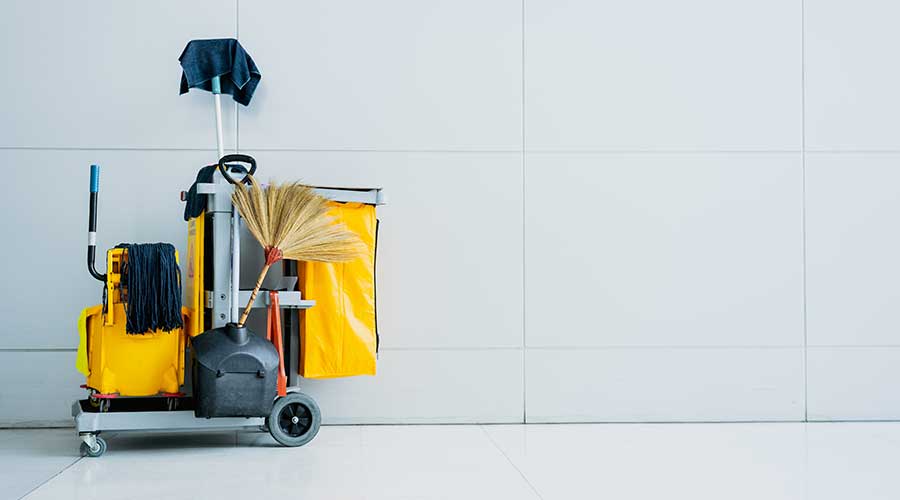Going with the Flow: Maintenance ensures pump performance
Pumps perform an essential function in all types of institutional and commercial facilities, directing and controlling the flow of water and other fluids throughout buildings. But too often, these key pieces of mechanical equipment fail, disrupting facility operations and potentially causing damage.
To ensure the long-term, cost-effective performance of these key components, maintenance and engineering managers need a strategy that addresses both the key initial steps — specification and installation — and the longer-term need for proper inspection and maintenance.
Pump Types
Key types of pumps fall into two categories — low-pressure and high-pressure. Most centrifugal pumps are low-pressure, high-volume design, to 300 psi. Hydraulic vane pumps are the choice for very-high- pressure applications, up to 3,500 psi for most gear- drive applications.
Other high-use pump types include:
- rotary, which are used for heavy or high-viscosity material
- piston or positive displacement, for chemical-feed applications
- vacuum, which are used for dewatering.
In the HVAC area, pumps are used for such services as boiler feed water, condensate return, and cooling-water circulation.
Pumps can be mounted with shafts aligned either vertically or horizontally, on direct-coupled drives, or belt-driven from parallel-shaft motors. The shafts are sealed with soft packing or mechanical seals. Bearings can be straight, spherical or tapered roller, ball, bronze, carbon, or Babbitt sleeves, depending on radial and thrust loads expected.
Designs include overhung shafts, where the motor shaft extends into the pump casing and turns an impeller, or separate motor and pump shafts, either belt-driven or direct-coupled.
A Maintenance Strategy
An effective pump maintenance program consists of six essential elements:
- proper pump specification for the application at hand
- proper installation
- preventive inspection, cleaning and minor adjustment
- preventive/predictive maintenance
- periodic manufacturer’s field test
- shutdown and overhaul at the optimum frequency.
Specifying the right pump for the application includes designating the:
- type, whether centrifugal, piston, gear or vacuum
- drive — direct-coupled or belt
- power source — electric motor, gas or diesel engine
- speed in rpm
- rotation, whether clockwise or counter-clockwise
- flow rate in gpm
- pressure in psi or feet head
- suction and inlet size, suction head, proper casing, casing wear rings, impeller, shaft sleeves and seals — mechanical or soft packing material — for the fluid pumped.
Proper pump installation varies by application, but following a manufacturer’s installation instructions is important. Managers also should order installation, operation, repair and preventive maintenance manuals, along with parts lists.
Managers and technicians next must address preventive maintenance (PM) for pumps. Among key PM steps for the most common type of pump — the centrifugal pump — are these:
Check for proper rotation of the drive consistent with the pump design.
Pipe fresh, clean water to the seals to prevent premature wear if the fluid is dirty.
Set the pump so the design suction head is delivered to the pump, keeping the pump flooded and helping to prevent cavitation.
Remove the vent plug, and force out air by letting water flow out the vent. Then replace the vent before starting the pump.
Lubricate the pump according to manufacturer specifications, removing bearing vent plugs for one-half hour of operation before replacing them in order to remove old lubricants, contaminants and moisture.
Check coupling alignment and bolt tightness with a torque wrench.
Alleviate pipe strain by inserting a flex pipe at either the inlet or the discharge. Strain causes bowl distortion, and it can result in leakage, wasted power and premature wear.
Finally, use one raised flange on high-pressure, flanged joints so that the high pressure on the gasket keeps a tight seal.
Technicians can perform preventive inspection, cleaning and minor adjustments at the same time on daily routes that are set up to cover the key equipment. Signs of trouble with pumps are either too much or too little water flow at seals, excessive vibration due to misalignment, impeller wear, bearing wear, or bent shafts. Inspectors should replace missing safety features, such as coupling guards.
Regular, daily inspections help technicians detect small problems before they become bigger, more costly problems. Managers should develop a facility layout showing the location of all critical pumps and use it as a road map that an inspector — a maintenance technician familiar with troubleshooting who can detect out-of-line conditions — can follow each day.
At each location, the inspector should look, listen and feel for irregularities with the operation of the pump. Look for signs of trouble, such as smoke, vibration or excessive leaks at shaft seals. Listen for louder-than-usual noises that might be the first signs of misalignment, bad bearings, foreign objects in the impeller, the impeller rubbing against the casing or cavitation, indicating it is running dry due to insufficient inlet flow. Feel for excess heat, vibration, irregular pump or motor bearing noises, dry bearings, or excessive shaft end-play. While a technician might not be able to shut a pump down because it must remain in service, he or she can note the problem on an inspection checklist.
Maintenance planners the collect and review the checklists, and if a condition is serious enough or if many small problems arise, planners can schedule a pump for repair during non-operating periods. This approach avoids unscheduled downtime occurs, as well as possible major damage to the pump.
Moving Beyond PM
Periodic PM, such as bearing underlubrication or overlubrication, packing adjustment, mechanical-seal replacement, pressure checks, flow checks, and gauge and valve adjustments help to keep key pump components in top shape.
Predictive maintenance (PdM) techniques also are invaluable for keeping pump reliability high and life-cycle costs low. Diagnostic monitoring during pump operation — including the use of such PdM technology as infrared thermography, vibration analysis, electrical monitoring, and lubricant analysis — often reveal early signs of trouble.
Infrared thermography can help detect unusual heat in gear boxes, electrical controls, motors and bearings that is undetectable by ordinary means. Vibration analysis can reveal unusual or dangerous vibrations, which can cause a shorter performance life or sudden downtime.
By comparing the vibration amplitude at different frequencies, a technician can pinpoint the component causing the problem without having to disassemble the pump. And by comparing actual performance data against a vibration severity chart, a technician can determine the optimum time for repair without causing any unscheduled downtime.
Finally, lubricant analysis helps technicians detect the presence of cuttings, moisture or deteriorated lubricant and, as a result, can prevent serious wear and premature bearing or gearbox failure.
Managers also have another resource to enhance pump performance. Periodic manufacturer field tests can reveal changes in requirements, lost capacity or unusual conditions that technicians might not detect during PM or PdM routines. Also, a manufacturer’s representative can check the actual performance against design specifications to predict a pump’s remaining performance life.
Test reports also can include recommendations for repair, major overhauls and replacement, as well as updates on new technology or upgrades to give managers the optimum available solution and the lowest life-cycle cost. By weighing this information, as well as data in the department’s maintenance management software on the equipment history and repair record, managers can be sure of making the right decision.
Technology Advances
Continued research and development in the pump industry is creating significant advances that can help managers find the right solutions for their facilities.
New-design, high-reliability, constant-pressure-booster systems for high-rise applications are available in duplex and triplex models with horizontal or vertical mountings. Here, the load is automatically shifted from one pump to the other seamlessly, based on a preset sequence loaded into a programmable logic controller. Technicians can inspect out-of-service pumps internally without having to disconnect piping, making repairs easier.
Also, more manufacturers are performing tests on each pump application before shipment, so customers can request to see the actual performance in order to verify the desired characteristics before taking delivery. A key test here is a vibration analysis at the actual range of operating conditions.
Manufacturers also are making more instrumentation standard, including inlet and discharge pressure gauges or flow meters to monitor operating conditions. They attach these instruments to a PC interface or collection device, which enables a technician to store minimum, maximum and instantaneous actual readings. This information is highly useful in determining changes in condition of the pump or operating demand variations.
Electric-motor-driven pumps account for 20 percent of electricity use, so more efficient electric motors are in demand for pump applications. The Hydraulic Institute supports the National Electrical Manufacturers Association’s premium-efficiency electric-motor program, and it applies the premium label to motors that meet an industry-defined high level of efficiency. Programmable controllers in the electric control panel allow for additional control and alarm features tailored to the application.
Finally, the search for a pump with no moving parts for water or fluids containing large solids is of great interest because the more moving parts, the more likely a pump will fail. Early operational tests under actual conditions in wastewater-handling applications indicate that such pump technology works even for difficult pumping tasks, such as moving solids as large as the piping diameter, without plugging up.
Related Topics:











